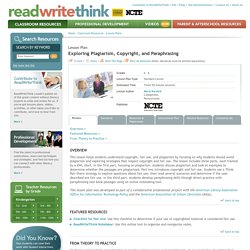

Please No Posers. Exploring Plagiarism, Copyright, and Paraphrasing. ReadWriteThink couldn't publish all of this great content without literacy experts to write and review for us.

If you've got lessons plans, videos, activities, or other ideas you'd like to contribute, we'd love to hear from you. More Find the latest in professional publications, learn new techniques and strategies, and find out how you can connect with other literacy professionals. All About Plagiarism Tutorial. 7 Resources for Detecting and Preventing Plagiarism. 1.

The first thing I do when I want to check a student's work for plagiarism is to do a quick search on Google. If you notice that a student has strung together some phrases that you don't think they've written, put the suspected phrase inside quotation marks and search. You may want to search on Google as well as on Google Scholar. Talking About Plagiarism. A Syllabus Strategy for Talking About Plagiarism with Students After reading Robert Harris's book, The Plagiarism Handbook: Strategies for Preventing, Detecting, and Dealing with Plagiarism (2001, from Pyrczak Publishing); an article on the role of honor codes by Robert Boynton in the Washington Post; and thinking about the many plagiarism discussions that have come up on professional listservs I participate on such as WPA, TechRhet, WCenter, it occurred to me that the first place to begin a better discussion with my students on plagiarism is in my own syllabus.

The syllabus, after all, is the contract I make with my class. It's the document that conveys my personality, my view of writing, and sets the tone and approach I want to take with my students (as well as the tone I want them to take with one another). Teachers use syllabi to set parameters, to layout conditions, to explain grades.